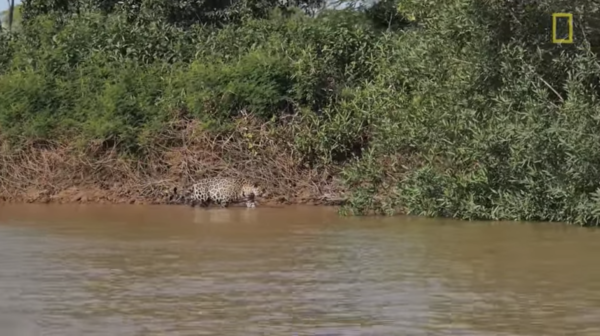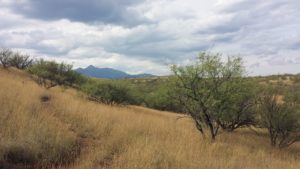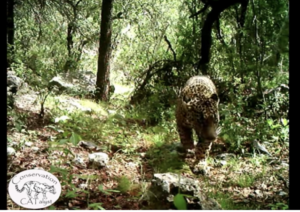Jaguars in the United States?
Jaguars in the United States are extremely rare today but historically they have roamed throughout the southern portions of the nation. Although they have been rarely been spotted in the US over the past century, there have been recent sightings indicating that jaguars might be moving back. Biophilia Foundation is working with groups in southeastern Arizona to help ensure jaguars will have migration corridors and habitat north of the border.
Jaguars Historic Range in the United States:
Prior to colonization, jaguar territory stretched from California to Texas. Some reports have the last known jaguar in California being killed on Mt. San Jacinto in the 1860’s. The 1905 “Biological Survey of Texas” cited at least ten specimens that had been collected throughout the southern half of the state during the last half of the 19th century. Some speculate that jaguars may have even populated the Carolinas in the early 1700’s.
Regrettably, jaguars were almost completely extirpated from the United States for the much of the 20th century. The last known female jaguar in the US was killed in the White Mountains of Arizona in 1963. A few males have been spotted sporadically.
Jaguars, however, have begun to return to the US in the last two decades. Most recently two male jaguars were spotted in southeastern Arizona. The jaguars were spotted in the Santa Rita Mountains (on US Forest Service land) and in the Huachuca Mountains (also on federally owned land). Local students named them El Jefe and Yo’oko.
Jaguar Natural History:
Jaguars (Panthera onca) are the largest felines in the western hemisphere. Their bodies can reach six feet in length with a three foot long tail. They can weigh as much as 250 pounds. Females give birth to a litter of one to four cubs and raise these cubs for two years or more.
Jaguars are carnivores and are amongst the best hunters on the planet. Even caimans have fallen prey to hunting jaguars. The jaguars nocturnal hunting tendencies lend it to much folklore. Mayan mythology, for example, includes numerous jaguar gods, such as the gods of the underworld, war, fires and fertility.
Read: Undeveloping for Wildlife

National Geographic video here of a jaguar swimming, stalking and pouncing on an unsuspecting caiman
The jaguar’s tan to orange skin contains rosettes. These rosettes are black spots shaped like a rose. Each set of rosettes are unique. You can identify individual jaguars by carefully examining their rosettes (like finger printing for humans).
As noted above the historic range of jaguars included the southern-most portions of the United States. Indeed, they were described as once being common in southern and eastern Texas. Today, their range is in Central America and South America as far south as northern Argentina with the core population living in the Amazon River basin. However, a narrow band of occupied jaguar habitat runs north through Mexico and stretches into the United States.
Hunting and loss of habitat have reduced jaguar populations. The International Union for Conservation of Nature (IUCN) list the jaguar as near threatened with a population trend that is declining.
Further Reading by Amy Mathews Amos: Can Saving Jaguars Sustain Local Economies?
Biophilia Foundation Helping Protect Jaguar Habitat Near Sonoita Creek in Arizona
The two recent jaguars spotted in Arizona were found near one another on federally owned property. Both sites provide sufficient habitat for jaguars to survive if left to their own devices. There is a stretch of land between the two federal parcels that could provide a critical travel corridor for jaguars and a host of other wildlife. The state of Arizona identified this area as the most important corridor for jaguars in the state. Unfortunately, the property was subdivided into 189 residential lots about ten years ago.
When the “Great Recession” slowed development plans, a group of concerned conservationists moved in and purchased the property. Biophilia Foundation has been advising and helping with funding to permanently protect the corridor.
The Sonoita Creek Wildlife Corridor will protect 1,000 of some of the most important acres of jaguar habitat in the United States. This corridor will connect the two core habitat areas for jaguars –the Santa Rita Mountains and the Huachuca Mountains, thereby improving the value of both areas.

Sonoita Creek Wildlife Corridor: Biophilia Foundation is working with local citizens and concerned conservationist across the United States to preserve this property in southeastern Arizona. The Arizona Fish and Game Department identified the property as the most important jaguar wildlife corridor in the state. Preserving this property will help establish a protected corridor for jaguar and other wildlife to utilize while traveling between the Santa Rita Mountains and the Huachuca Mountains. You can support this exciting preservation opportunity by donating to Biophilia Foundation here: https://www.biophiliafoundationstore.org
Threat To the Jaguar In the US Remain
A host of threats remain. These threats imperil the jaguar’s chances of repopulating the US. Ranchers in Mexico killed Yo’oko when he ventured south. El Jefe has not been seen in many months. Human attitudes towards large predators remain a great barrier towards restoring healthy populations of jaguars.
And finally, the border wall proposed by Donald Trump would have a terrible impact on jaguars moving through their habitat in northern Mexico into the southern US. In addition to the numerous outrages it would deliver (moral, financial, environmental), the border wall would prevent the ability of jaguars to naturally repopulate the United States.
Sources:
“Arizona’s Wildlife Linkages Assessment”; prepared by The Arizona Wildlife Linkages Workgroup; 2006.
Bailey, Vernon; “Biological Survey of Texas; Government Printing Office; Washington DC; 1905.
Bernard, Stephen and Kenneth Brown; “Distribution of Mammals, Reptiles and Amphibians”; US Department of Interior Bureau of Land Management; Denver, CO; 1974.
https://blog.nationalgeographic.org/2015/12/24/secrets-of-the-worlds-38-species-of-wild-cats/
Davis, W.B.; “Cats of Texas”; Texas Parks and Wildlife Department; Austin, TX; 2000.
https://www.iucnredlist.org/species/15953/123791436
https://www.nationalgeographic.com/animals/mammals/j/jaguar/
Rodriguez-Mejia, Fredy R. and James B. Sexton; “Depictions of Animals in the Popol Vuh and Current Mayan Folktales”; Latin American Indian Literatures Journal; Vol. 26, No. 1; Spring 2010; p.1-27.
https://www.smithsonianmag.com/science-nature/return-of-the-jaguar-110630052/?no-ist
https://www.smithsonianmag.com/science-nature/return-great-american-jaguar-180960443/
https://www.theatlantic.com/national/archive/2016/02/one-is-the-loneliest-number/459828/


Recent Comments